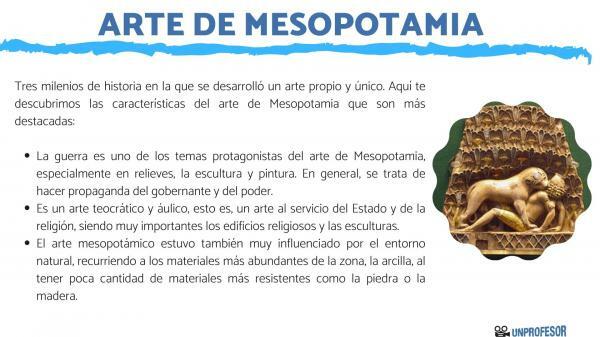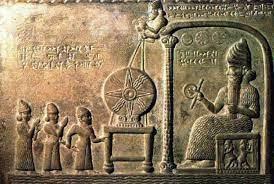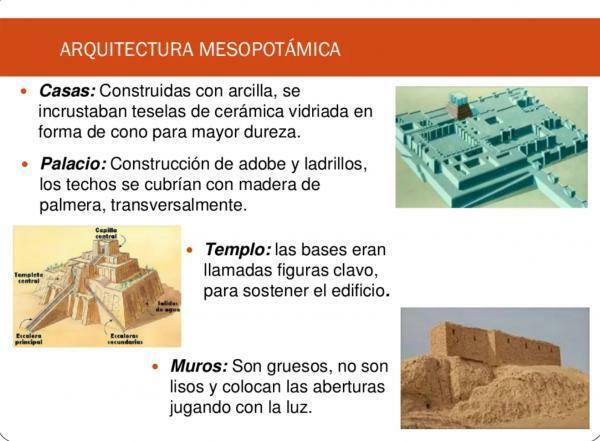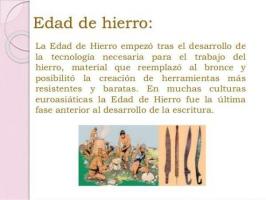Art of MESOPOTAMIA: main characteristics

Mesopotamia it's a geographic area located between the Tigris and Euphrates rivers and that it is considered as the cradle of antiquity and a land in which various cultures and civilizations flourished such as the Sumerian, the first civilization of the world, the Akkadian, the Babylonian or Chaldean, the little house, the Hurrian or Mittani and the Assyria. An art that temporarily extends between the Neolithic or the fall of Babylon to the Persians in 539 BC.
A cultural diversity that materialized in numerous artistic and craft techniques, as well as different styles, shapes and themes. Although chronologically its historical evolution is similar to that of the Egyptian civilization, there are not so many remains due to the lack of stone, wood and metals and use more crumbly materials such as clay, adobe bricks, a mixture of adobe and straw, and glass. In addition, an important part of that heritage was excavated and taken to foreign museums or suffered serious destruction and looting during the Iraq War.
In this lesson from unPROFESOR.com we offer you a summary of art in Mesopotamia and its characteristics to get closer to one of the most significant areas and times in the history of Humanity.
Index
- Art periods in Mesopotamia
- Characteristics of Mesopotamian art
- Characteristics of Mesopotamian architecture
- Characteristics of Mesopotamian sculpture
- Characteristics of Mesopotamian painting
Periods of art in Mesopotamia.
We begin this summary of art in Mesopotamia by analyzing the different historical periods into which this moment of our history is usually divided.
Sumerian art (4000-2000 BC)
Sumerian It was located in the southern part of the Mesopotamian region, dedicating itself to agriculture and commerce. A civilization of independent city-states, but under the all-encompassing power of a sovereign who combines political and religious power, it is a representative of God, and a priestly caste. Society is also highly hierarchical.
The main cities are Uruk, Ur, Lagash and Nippur. They invented the calendar, the wheel and the cuneiform writing.
Akkadian, Babylonian and Assyrian art (1800-539 BC)
These towns were located in the central and northern part of the region. Very militarized civilizations and under a very authoritarian power focused on territorial dominance. Society is highly hierarchical and organized.
- The acadians they invaded Sumer in 2400 BC and founded cities such as Babylon and Akkad, adopting the Sumerian culture.
- First Babylonian Empire (2000-1595 BC). One of the great cultural centers was Babylon under the reign of Hammurabi, sovereign creator of the world's first legal document, the Code of Hammurabi.
- Assyrian Empire (1360-612 BC). Town of the north of Mesopotamia, owner of a powerful army and counting on main governors to Sargon II, Sennaquerib and Asurbanipal. The capital was located in Nineveh and due to the harshness of its measures and dominance it gave rise to a revolt of Babylonians, Medes and Persians.
INeo-Babylonian empire (613-539 BC)
Babylon became the artistic, political and economic center in the Middle East under the reign of Nebuchadnezzar II.

Characteristics of the art of Mesopotamia.
We are in the lands of Babylon, Ur and Nineveh, the birthplace of cuneiform writing, the Hammurabi Code, from the biblical stories of Noah and the Flood, from the Tower of Babel, the Hanging Gardens and great and powerful kings like the mythical King Solomon.
Three millennia of history in which his own and unique art was developed. Here we discover the characteristics of the art of Mesopotamia that are most outstanding:
- War is one of the main themes of Mesopotamian art, especially in reliefs, sculpture and painting. In general, it is about making propaganda for the ruler and the power.
- It's a theocratic and classroom art, that is, an art at the service of the State and religion, religious buildings and sculptures being very important.
- Mesopotamian art was also very influenced by the natural environment, resorting to the most abundant materials in the area, clay, having a few more resistant materials such as stone or wood.

Characteristics of Mesopotamian architecture.
The Mesopotamian architecture had the following main characteristics:
- The arch, the vault and the lintel were used.
- The main constructions are the palaces and the temples.
- Some constructions that are characterized by their monumentality.
- The walls are thick, vertical and smooth.
- Pillars and columns are used as supporting elements, although the latter with an ornamental rather than an architectural function.
As we have already pointed out, by geographical location, the main construction materials were adobe bricks, with stone and wood being very scarce.
In addition, in this type of architecture it was mostly lintel, with wooden beams, with the presence also of the vault and the arch, differing from Egyptian architecture for giving Mesopotamian art less relief to funerary constructions, standing out mainly the temples and the palaces.
Between the main constructions of Mesopotamian art are:
The temple
It is a building that consists of a large walled courtyard and that has one of its most representative constructions, the ziggurat, on one of its sides. A stepped building that features a sanctuary at its top. Each of its sides is oriented to a cardinal point, going up from floor to floor by a ramp that surrounds the entire building or by two symmetrical stairs on the front or on the sides.
Sumptuous materials such as marble, lapis lazuli, alabaster or gold were used for its construction.
The Ziggurat of Ur stands out, a temple executed in honor of the goddess Nanna or goddess of the moon.
The palace
It did not have a defined shape, being a series of buildings in a prismatic shape and of different sizes that were communicated by galleries and corridors with patios in intermediate areas and surrounded by walls. The final floor used to be quadrangular with a central patio with a ventilation and light point.
Palaces used to be built on the slopes to preserve them from rising rivers and winged and bearded bulls were placed at their entrance as protective deities.
The interiors were decorated with frescoes and beautiful glazed brick wall tiles in bright colors and reliefs. The most important palaces were those of Nineveh, Korsabaad, Nimrud or the mythical palace of Nebuchadnezzar II, famous for their hanging gardens.
The palace of Mari (18th century BC. C.) is the oldest preserved palatial structure, although they already existed in the cities of Lower Mesopotamia in earlier times, and in it already that rectangular modular plan, inspired by popular dwellings, is reproduced, adding elements such as vaults, columns, stairways and decor.
The walls
With vertical walls and right angles, it had reinforcements of square towers in each section. The entrance was made through large fortified doors, finishing the passage with a half-barrel vault and flanking the access by two protective statues.
Among the doors stands out the ishtar gate dates from 575 a. C. roughly built by Nebuchadnezzar II. Currently a reconstruction is preserved in the Pergamon Museum in Berlin. The facade was adorned with silhouettes of bulls, dragons and lions. This is one of the eight monumental gates inside the wall of Babylon.
The tombs
They are really simple constructions, basically a hypogeum with several chambers and small monuments. The grave goods were very rich.

Characteristics of Mesopotamian sculpture.
We continue to know Mesopotamian art focusing, now, on the sculpture. The most outstanding characteristics of this type of art are:
- Mesopotamian period sculptures are characterized by their symmetry and follow the law of frontality, that is, they are representations that show the figures looking straight ahead and in a rigid and static posture.
- They are not very expressive and they have wide, almond-shaped eyes.
- They are usually the representations of gods, mythological figures, kings and senior officials.
- They do not keep proportions between the head and the body.
By not having stone in abundance, the sculpture was a luxury and quality item reserved only for the elites, the pieces being made on sumptuous materials such as ivory or amber. The animal representations were more realistic than the human ones, the latter being very robust and full of force.

Characteristics of Mesopotamian painting.
To close this summary of the art in Mesopotamia it is important that we also talk about some of the best known and most consecrated artistic expressions: the painting. The differentiating elements of painting in ancient Mesopotamia are the following:
- Doesn't use perspective and it has a very small palette of colors, usually red, blue and white.
- The technique used is that of temper
- Its purposes are aesthetic and their objective was to beautify palaces and temples.
- Topics are usually warlike, religious, animals, legends and representations of everyday situations or ritual sacrifices.
- The reliefs use the overlapping figures to get the feeling of depth.
- Too mosaics abound ceramic tiles with geometric motifs or polychrome ceramic brick faces.
- The reliefs are usually made on platelets and stelae in which they also appear cuneiform texts.
- Are thorough and naturalistic, reflecting many details.
- Kings are always represented in an upright position, standing out above the rest and always in scenes of war, hunting or ceremonial banquets.
- Among the stelae stands out the Stele of the Code of Hammurabi it is kept in the Louvre Museum in Paris. A stela in which 282 articles appear engraved in cuneiform writing, regulating agriculture, commerce, marriage, and the purchase and sale of slaves, among other matters. Another was the Stela of Ur, a bas-relief from 2500 BC. C.

If you want to read more articles similar to Art of Mesopotamia: summary, we recommend that you enter our category of History.
Bibliography
- SANMARTIN, J; (2006) Mesopotamia and its areas of influence, ed. Akal, Madrid
- OPPENHEIM, A. L; (2003) Ancient Mesopotamia: Portrait of an Extinct Civilization, ed. Gredos, Madrid.
- LEICK, G (2002) Mesopotamia: the invention of the city, ed. Paidós Ibérica, Barcelona
- RAMIREZ, J. A (dir) (2001) History of Art. The Ancient World, ed. Alliance, Madrid
- LVAR, J (1989) The keys of Mesopotamian and Persian Art, ed. Ariel, Barcelona
- LARA PEINADO, F; (1989) The Sumerian Civilization, ed. History 16, Madrid
- FRANKFORT, H; (1982) Art and architecture of the Ancient East, ed. Chair, Madrid



